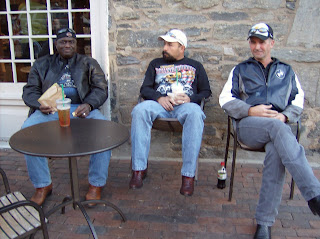
O tanara mama, alaturi de pruncul aflat in leagan. Imaginea revine de nenumarate ori in
Intolerance, filmul lui
Griffith, facut in 1916. Scena leaga intre ele episoadele filmului, desfasurate fiecare in spatii geografice extrem de diferite si in perioade istorice extrem de diferite. Sa observam ca imaginea tinerei mame aflata langa pruncul din leagan nu are o localizare in timp sau spatiu: imaginea aceasta este liantul filmului tocmai pentru ca poate fi oriunde si oricand. Este imaginea esentiala a rostului vietii, ne spune
Griffith. Viata inseamna dragoste care creaza.
Tanara mama este interpretata de o actrita celebra a acelor ani,
Lilian Gish. In maini tine o carte. Este greu, desigur, sa vedem titlul cartii. Diversi comentatori ne asigura ca este un volum de versuri:
Leaves of Grass, al lui
Walt Whitman. Iar cartea este deschisa la un poem intitulat
Out of the Cradle Endlessly Rocking:
Out of the cradle endlessly rocking,
Out of the mocking-bird’s throat, the musical shuttle,
Out of the Ninth-month midnight,
Over the sterile sands, and the fields beyond, where the child, leaving his bed, wander’d alone, bare-headed, barefoot,
Down from the shower’d halo
Asocierea imaginii din film cu versurile avantate ale lui Whitman creaza un contrapunct superb. Pruncul va parasi leaganul ca sa isi traiasca din plin viata, dar aici este inceputul vietii, este esenta din care se va dezvolta totul:
Out from the patches of briers and blackberries,
From the memories of the bird that chanted to me,
From your memories, sad brother—from the fitful risings and fallings I heard,
From under that yellow half-moon, late-risen, and swollen as if with tears,
From those beginning notes of sickness and love, there in the transparent mist
Iar filmul este despre opozitia dintotdeauna intre aceasta imagine esentiala a vietii si raspunsul pe care il da societatea. Intoleranta, oarba la esenta vietii, distrugand viata. Societatea care distruge Evanghelia Iubirii in numele Legii si care distruge Iubirea in numele Evangheliei. Razboaiele dintre cei care cred in Isus si cei care cred in Iisus. Societatea care distruge zeii tai pentru a pune in loc zeii mei. Terorizarea saracilor in numele operelor de binefacere.
----------------------------
Iar imaginea tinerei mame, langa pruncul din leagan, revine, mereu si mereu:
From the thousand responses of my heart, never to cease,
From the myriad thence-arous’d words,
From the word stronger and more delicious than any,
From such, as now they start, the scene revisiting,
As a flock, twittering, rising, or overhead passing,
Borne hither—ere all eludes me, hurriedly,
A man—yet by these tears a little boy again,
Throwing myself on the sand, confronting the waves,
I, chanter of pains and joys, uniter of here and hereafter,
Taking all hints to use them—but swiftly leaping beyond them,
A reminiscence sing.
---------------------------------------------
Daca e sa incerc o ierarhizare,
Intoleranta mi se pare mai important decat
Potemkin sau
Octombrie, pentru ca le premerge.
Sigur,
Eisenstein, la zece ani dupa
Griffith, e matur, putem vedea filmele lui fara sa zambim ingaduitori - filmele lui nu dau nici un semn de batranete. Si este apoi o alta deosebire: sentimentalismul filmului lui
Griffith si patosul filmelor lui
Eisenstein.
Intoleranta este plin de naivitatile inceputului, de melodrama - este pe de alta parte extrem de ambitios - ceea ce poate ca il aduce periculos de aproape de ratare (dar ii da si marca geniului) - insa tot mestesugul cu care ma delecteaza filmele lui
Eisenstein - ei bine, totul, se afla acolo, in
Intoleranta.
Ritmul fantastic - filmul dureaza trei ore, mergand in paralel pe patru naratiuni - in America inceputului de secol, in Iudeea Evangheliilor, in Parisul Noptii Sfantului Bartolomeu, in Babilon - nu te plictistesti, nu te enerveaza toata naivitatile si ingrosarile, nu te enerveaza didacticismul evident - in primul rand pentru ca ritmul viguros al filmului nu iti da o clipa de ragaz. Iar
David Wark Griffih trece genial dintr-o poveste in alta, are grija sa le evolueze in acelasi tempo - si are siguranta trecerii de la filmarea de departe la close-up - si are mai ales geniul scenelor de masa - furnicarul de oameni aia care se misca apoi in
Potemkin si in
Octombrie, se misca magistral mai intai aici, in Babilonul inchipuit de
Griffith - si are suflu, nu si-l pierde, exact cum
Eisenstein va avea acelasi suflu peste zece ani - respiratia unui atlet, a unei locomotive, vigoare.
Iar scena marii piete publice din Babilon, filmata de sus, cu miscarea oamenilor peste tot, pe scari (scarile din
Potemkin sunt deja acolo, in Babilonul lui
Griffith), pe marele platou, pe balcoanele palatelor - poate ca este cea mai extraordinara scena de masa din toata istoria filmului. Sigur ca
Griffith isi imparte meritele cu cameramanul,
Billy Bitzer.

Trei mari regizori care au avut alaturi de ei trei mari cameramani:
Griffith cu
Billy Bitzer,
Eisenstein cu
Eduard Tisse,
Wong Kar-Wai cu
Chris Doyle. Ei au creat acele cateva momente esentiale care marcheaza istoria cinematografului.
Da,
Intoleranta este un film esential. Se gaseste pe web, impartit in trei bucati de cate o ora - partea
intaia, a
doua si a
treia.
Labels: Billy Bitzer























